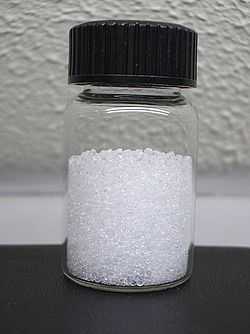Potassium alum
| Potassium aluminium sulfate | ||
|---|---|---|
 | ||
| Other names Potassium alum | ||
| Identifiers | ||
| CAS number | 10043-67-1 7784-24-9 (dodecahydrate) | |
| PubChem | 24856 | |
| Jmol-3D images | {{#if:[O-]S(=O)(=O)[O-].[O-]S(=O)(=O)[O-].[Al+3].[K+]|Image 1 | |
| ||
| ||
| Properties | ||
| Molecular formula | KAl(SO4)2 | |
| Molar mass | 258.205 g/mol | |
| Appearance | white small crystals | |
| Odor | watery metallic | |
| Density | 1.725 g/cm3 | |
| Melting point | 92–93 °C | |
| Boiling point | 200 °C | |
| Solubility in water | 14.00 g/100 mL (20 °C) 36.80 g/100 mL (50 °C) | |
| Solubility | insoluble in acetone | |
| Refractive index (nD) | 1.4564 | |
| Hazards | ||
| NFPA 704 |
 0
2
0
| |
| Except where noted otherwise, data are given for materials in their standard state (at 25 °C (77 °F), 100 kPa) | ||
| Infobox references | ||
Potassium alum, potash alum, tawas, or potassium aluminum sulfate is a chemical compound: the potassium double sulfate of aluminium. Its chemical formula is KAl(SO4)2 and it is commonly found in its dodecahydrate form as KAl(SO4)2.12(H2O). Alum is the common name for this chemical compound, given the nomenclature of potassium aluminum sulfate dodecahydrate. It is commonly used in water purification, leather tanning, dyeing,[citation needed] fireproof textiles, and baking powder. It also has cosmetic uses as a deodorant, as an aftershave treatment and as a styptic for minor bleeding from shaving.[4]
Characteristics

Potassium alum crystallizes in regular octahedra with flattened corners, and is very soluble in water. The solution reddens litmus and is an astringent. When heated to nearly a red heat it gives a porous, friable mass which is known as "burnt alum." It fuses at 92 °C (198 °F) in its own water of crystallization. "Neutral alum" is obtained by the addition of as much sodium carbonate to a solution of alum as will begin to cause the separation of alumina.
Mineral form and occurrence
Potassium alum or alum-(K) is a naturally occurring sulfate mineral which typically occurs as encrustations on rocks in areas of weathering and oxidation of sulfide minerals and potassium-bearing minerals. In the past, alum was obtained from alunite, a mineral mined from sulfur-containing volcanic sediments source.[5] Alunite is an associate and likely potassium and aluminium source.[3][6] It has been reported at Vesuvius, Italy, east of Springsure, Queensland, Alum Cave, Tennessee, Alum Gulch, Santa Cruz County, Arizona and the Philippine island of Cebu. A related mineral is kalinite, a fibrous mineral with formula KAl(SO4)2·12(H2O).[7]
Uses
Chemical
- in tanning of leather to prepare the hide
- as a mordant for dyes
- in the clarifying of turbid liquids, including post-storm treatment of lakes to precipitate contaminants[8]
- as a fire retardant in textile products
- (historically) as a hardener for photographic emulsions (films and papers), usually as part of the fixer. Modern alternatives are superior.
Medicinal
- as an astringent/styptic and antiseptic.
Culinary
- As an additive to baking powder to provide a second leavening phase at high temperatures.
Traditional
- In Ayurveda, where it is called phitkari or saurashtri
- In traditional Chinese medicine it is called ming fan.[9]
Toxicology and safety
Deodorant crystals containing synthetically made potassium alum are a weak irritant to the skin.[10]
See also
References
- ↑ International Union of Pure and Applied Chemistry (2005). Nomenclature of Inorganic Chemistry (IUPAC Recommendations 2005). Cambridge (UK): RSC–IUPAC. ISBN 0-85404-438-8. Electronic version.
- ↑ "Aluminium potassium sulfate dodecahydrate". ChemExper. Retrieved 2013-04-19.
- ↑ 3.0 3.1 "Alum-(K) Mineral Data". Mineralogy Database. Retrieved 2013-04-19.
- ↑ 4.0 4.1 Helmenstine, Anne Marie. "What is Alum?". About.com. Retrieved 2013-04-19.
- ↑ Bottomley (2010) p. 35
- ↑ "Alum-(K) mineral data and informaton". MinDat. Retrieved 2013-04-19.
- ↑ "Kalinite Mineral Data". MinDat. Retrieved 2013-04-19.
- ↑ http://www.engr.wisc.edu/news/archive/2013/aug20.html
- ↑ http://tcm.health-info.org/Herbology.Materia.Medica/mingfan-properties.htm Uses of Alum in Traditional Chinese Medicine
- ↑ Gallego H, Lewis EJ, Crutchfield CE 3rd (July 1999). "Crystal deodorant dermatitis: irritant dermatitis to alum-containing deodorant". Cutis 64 (1): 65–6. PMID 10431678.
Further reading
- Bottomley, L.; Bottomley, L.A. (2010). School of Chemistry & Bichemistry, Georgia Institute of Technology, Chemistry 1310: Laboratory Manual. Plymouth, MI: Hayden-McNeil Publishing. ISBN 978-0-7380-3819-3.